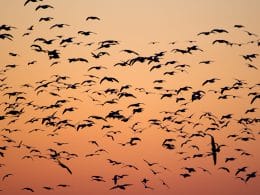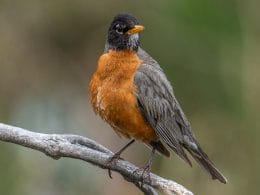Owls are amazing birds that are typically active during the evening and night. Being silent, noctural fliers, you are very lucky if you see them in the air. The ABA (American Birding Association) lists 23 species of owl in the United States and they are all carnivorous. In this post, we will be looking in more detail at what owls eat.
Common Species of Owl
Barn Owl (Tyto alba)

The Barn Owl is the most common species in the world. It is present in all environments except for extreme hot and cold climates. This owl is incredibly adaptable and its success is partly due to its ability to fit in with human habits and its secretive nature that keeps it out of human reach.
Range

Habits
Only occasionally seen during the day, the Barn Owl generally hunts during the hours of darkness. It flies fairly low to the ground in open habitats. This owl learns from experience and will return to areas where it has successfully caught prey on previous occasions and they can discern between animal noises to identify their intended target.
Great-horned Owl (Bubo virginianus)

The Great-horned Owl is another adaptable bird, found in all but Arctic regions. Its range is extensive and it is an opportunistic feeder taking a wide range of prey.
Range

Habits
The Great-horned Owl can be seen at times during daylight hours but mainly hunts at night. It sits and waits for prey from any natural or man-made structure. It will, however, look for mammals and waterbirds in flight. At times, it will even walk on the ground to stalk prey.
Short-eared Owl (Asio flammeus)

The Short-eared Owl is widely distributed across Eurasia and North America and it breeds as far north as Iceland and as far south as South America. It can be nomadic as it follows food sources like mammals.
Range
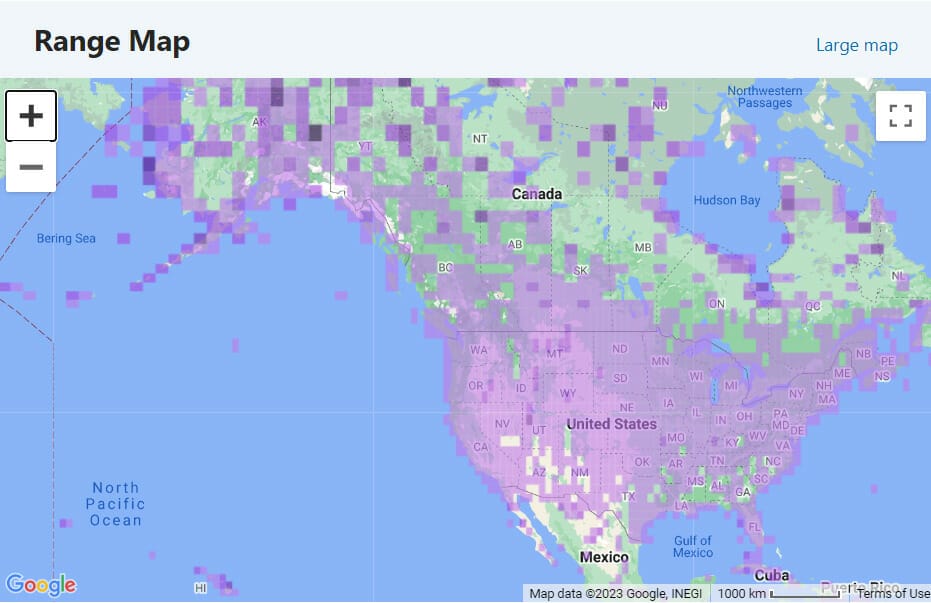
Habits
This owl nests on the grounds and so looks for suitably dense vegetation. It is usually found in swamps and marshland. It is active throughout the day, as well as at night and flies low to the ground in search of prey. Numbers of the Short-eared Owl have declined due to habitat loss.
Eastern Screech-Owl (Megascops asio)

Widely spread across the center and eastern part of continental United States, the Eastern Screech-Owl prefers forests at low altitude and is known to nest in urbanised places.
Range

Habits
The Eastern Screech-Owl is another forest dwelling bird that will accomodate human interruption. It perches during night hours looking for prey beneath it. At times, it will hunt at dawn and dusk or during the day.
Barred Owl (Strix varia)

The Barred Owl can be found across the United States but doesn’t like drier areas of the mid and far west. It has been successful in the last century and is expanding its area.
Range
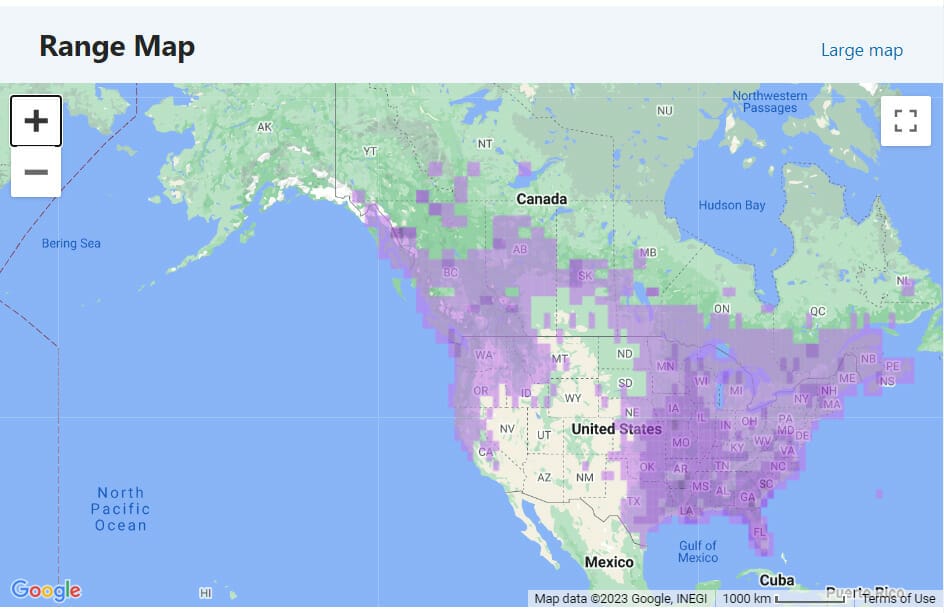
Habits
The Barred Owl hunts in the day, but mostly at night. It is another perching hunter, sitting while watching and listening. It can also run on the ground to catch an elusive prey.
Northern Saw-whet Owl (Aegolius acadicus)
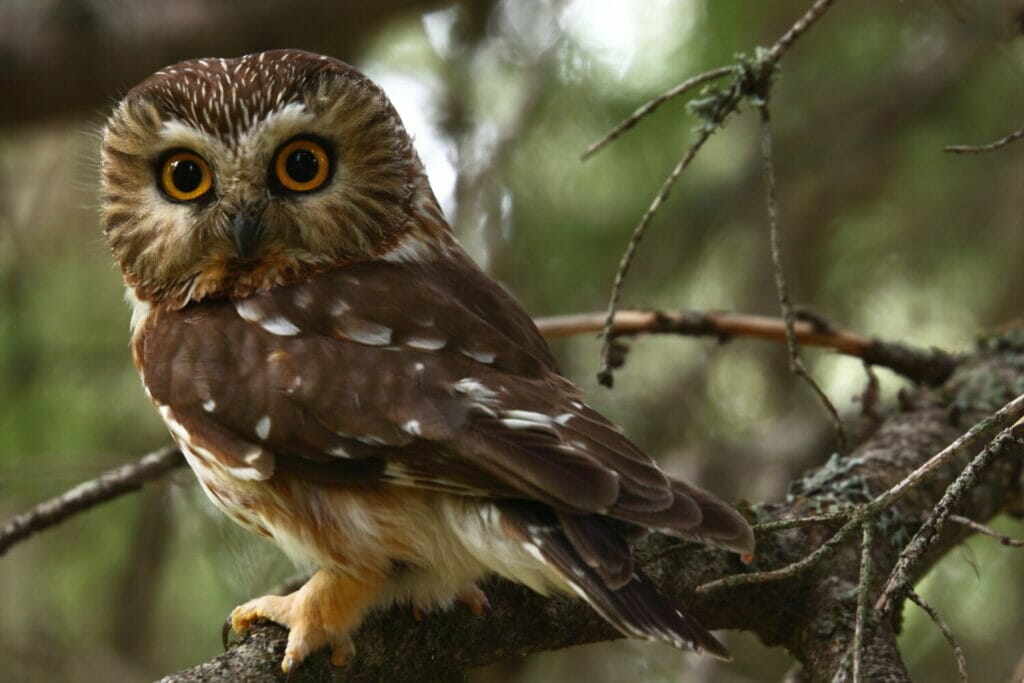
The Northern Saw-whet Owl is widespread across the northern parts of the U.S. and southern areas of Canada. They may move further south during the winter months. It is a small owl, weighing around 5 ounces.
Range

Habits
As a small owl, it perches lower to the ground waiting to find prey. Its preferred habitat is on the edge of forests and it hunts during the night, rarely being seen in the day.
Burrowing Owl (Athene cunicularia)

The Burrowing Owl is a very photogenic bird and accessible as it is active during the day and night. It is dependant on mammalian burrowing animals and the reduction in their numbers have impacted on the owls’ success. While it is not classed as Endangered in the United States, there is concern about the declining numbers.
Range

Habits
The Burrowing Owl is a well recognized feature of dry regions in the west of the U.S. and Florida. It nests underground in small groups and looks for food on the ground and in the air.
How do Owls Hunt?
Unfortunately for owls, hunting and catching small mammals is not an easy task. These animals are quick and have coloring that acts as camouflage and helps them hide away from any predators. For these reasons, owls can spend the majority of their active time hunting but they do have some advantages to make this task easier.
Owls Have Amazing Hearing
Owls typically have very flat faces and have their ears hidden on the sides of their heads. The feathers that surround their faces act to direct sound waves to their ears so that they can pick up on quiet sounds. Many owls have asymmetrical ears as well. This allows them to more accurately judge distances and makes hunting even easier.

Owls Are Very Stealthy
Although owls have amazing hearing abilities, their prey doesn’t have the same luxury. Owls can fly very quietly and are almost silent when they take to the air. This means that their prey cannot hear an owl coming until it is too late to hide.
Owls also have very large wingspans and the surface of their wings is very large in comparison to their body weight. This allows owls to glide silently through the air and drop to the ground without being heard.
Owls Do Not Have Teeth
Owls can’t chew as they don’t have any teeth. This may seem strange considering their diet consists purely of meat as typically, meat needs to be torn and chewed so that it can be consumed. Instead, owls use their bills to tear into the flesh of their prey.
They have so much strength and sharpness in their bills that they can even crush the bones of their prey. When hunting, owls will either crush their prey with their bill or their talons.
For some owls that target smaller prey, they don’t need to tear into their prey at all. Instead, they simply swallow their prey whole and let their digestive system take care of breaking down the bodies and flesh. There are some parts that owls cannot digest, such as bones, fur, and feathers, and these are later regurgitated as pellets.
How do we Know What Owls Eat?
This might seem like an easy question to answer but it really isn’t! Owls are generally nocturnal and quite secretive animals, so finding out what each species eats can be more difficult than you think.
With over 200 different species of owls spread across the world and in various types of habitats, their diets can be very varied. Different owls have different dietary requirements and the environments they live in can also dictate what food sources are available.
Thankfully, scientists, naturalists, and owl watchers can discover what owls eat through a variety of different methods.
Many owls eat small mammals and finding the remains of their prey near known owl nests and roost sites is a sure sign that they are being eaten by any specific group of owls. Also, it’s not unusual for some species of owls to store food in their nests and roosts in the same way that humans use pantries.
Another reliable source of information regarding what owls eat comes from owl pellets. These are made of the parts of the food that owls are unable to digest. For example, if an owl eats a small mammal, then the pellets are likely to be made from feathers, bones, fur, and teeth. Analyzing the contents of these pellets helps us to understand which prey the owls have eaten.

What do Owls Eat?
We know that owls are carnivorous and so they exclusively eat meat. What that meat is, largely depends on what is available. Owls are enormously adaptable and will eat a wide range of foods. Just thinking about the owls listed above, they will eat the following:
- Small mammals – rodents, shrews, rabbits, bats, gophers, voles, ground squirrels
- Birds – as large as ducks, geese and heron and smaller songbirds
- Reptiles
- Amphibians
- Arthropods – invertebrates with an exoskeleton like crabs, crayfish, spiders, insects, centipedes, worms
- Carrion (occasionally)

Final Thoughts
In this article, we answered the question of what owls eat. We learned that although owls are exclusively carnivorous animals, their diet can vary from species to species.
Mammals are the most popular form of meat for owls but others will eat insects, reptiles, or birds.
We hope that you enjoyed this article and it answered all of your questions about what owls eat.
FAQ
Definitely not bird feeders! It is difficult to attract owls to a garden because they like to hunt live animals. Putting out meat may not do the trick. If you live somewhere rural where there are lots of small mammals like mice and rabbits, then you might get lucky and see one.
Owls are generally roosting in the day. This can be in a burrow or nesting hole or simply on a branch. If they are around and other birds can see them, it is likely that there will be a lot of noise as they try to get it to move away. I found the Barn Owl pictured above by investigating a lot of noise being made by smaller birds.
The short answer is yes, if they can catch them. Cats are certainly in the food groups that owls feed from. A larger owl like the Great-horned is perfectly capable of taking a cat.
Generally owls are safe from predation. Smaller owls may be preyed upon by bigger owls but other ground dwelling predators will struggle to catch an owl.







